-
 Bitcoin
Bitcoin $117,576.6195
-0.21% -
 Ethereum
Ethereum $2,938.5668
-1.35% -
 XRP
XRP $2.7699
4.60% -
 Tether USDt
Tether USDt $1.0003
0.01% -
 BNB
BNB $688.1624
-0.01% -
 Solana
Solana $160.5113
-1.95% -
 USDC
USDC $0.9999
0.01% -
 Dogecoin
Dogecoin $0.1976
-0.70% -
 TRON
TRON $0.3008
1.54% -
 Cardano
Cardano $0.7159
-2.16% -
 Hyperliquid
Hyperliquid $46.2240
2.04% -
 Stellar
Stellar $0.3966
22.03% -
 Sui
Sui $3.3928
-3.11% -
 Chainlink
Chainlink $15.1204
-2.43% -
 Bitcoin Cash
Bitcoin Cash $515.1741
-1.19% -
 Avalanche
Avalanche $20.8130
-0.90% -
 Hedera
Hedera $0.2001
-2.12% -
 UNUS SED LEO
UNUS SED LEO $9.0522
0.72% -
 Shiba Inu
Shiba Inu $0.0...01316
-2.01% -
 Toncoin
Toncoin $2.9843
0.61% -
 Litecoin
Litecoin $92.6745
-2.71% -
 Polkadot
Polkadot $3.9483
-0.06% -
 Monero
Monero $328.5347
1.10% -
 Dai
Dai $0.9998
0.01% -
 Ethena USDe
Ethena USDe $1.0006
-0.01% -
 Uniswap
Uniswap $8.3739
-6.50% -
 Bitget Token
Bitget Token $4.4241
-1.99% -
 Pepe
Pepe $0.0...01222
-3.96% -
 Aave
Aave $300.5203
-3.61% -
 Bittensor
Bittensor $382.2607
-1.92%
What is Avalanche (AVAX)
Avalanche (AVAX) is a fast, scalable blockchain platform enabling dApps, custom networks, and EVM-compatible smart contracts with low fees and sub-second finality via its Snowman consensus.
Jul 11, 2025 at 05:35 am

Understanding the Basics of Avalanche (AVAX)
Avalanche (AVAX) is a blockchain platform designed to facilitate fast, secure, and scalable decentralized applications (dApps) and custom blockchain networks. It was developed by Ava Labs and officially launched in 2020. The native cryptocurrency of the Avalanche ecosystem is AVAX, which serves multiple purposes including staking, transaction fees, and governance.
Unlike traditional blockchains that rely on a single chain for processing transactions, Avalanche utilizes a multi-chain architecture, consisting of three distinct blockchains: the Exchange Chain (X-Chain), Contract Chain (C-Chain), and Platform Chain (P-Chain). Each chain has a specific role—issuing assets, executing smart contracts, and coordinating validators, respectively.
The platform's consensus mechanism is another standout feature. Instead of using Proof-of-Work or standard Proof-of-Stake, Avalanche employs a novel consensus protocol called Snowman, which allows for high throughput and sub-second finality. This makes it significantly faster than many other blockchain platforms.
The Role of AVAX in the Ecosystem
AVAX tokens are essential for maintaining network security and functionality. Users must pay transaction fees in AVAX, and validators are required to stake AVAX to participate in consensus. The token also plays a key role in governance, allowing holders to vote on proposed changes to the network.
One notable aspect of AVAX is its capped supply of 720 million tokens, making it a deflationary asset over time as transaction fees are burned. This scarcity model can potentially increase demand and value as adoption grows.
Validators earn rewards in AVAX for securing the network, but they must maintain a minimum stake amount and ensure uptime. If a validator behaves maliciously or fails to perform adequately, their staked AVAX may be slashed, incentivizing honest participation.
How Avalanche Differs from Other Blockchains
When compared to Ethereum, Avalanche offers much faster transaction times and lower fees, while still supporting Ethereum Virtual Machine (EVM)-compatible smart contracts. Developers familiar with Solidity can easily deploy their dApps on Avalanche without needing to learn new tools or languages.
Another unique characteristic is the ability to create custom blockchains within the Avalanche ecosystem. Using the Subnet framework, enterprises and developers can launch private or public blockchains tailored to their specific use cases. These Subnets operate independently but benefit from the overall security and interoperability of the Avalanche network.
Interoperability is further enhanced through bridges and integrations with other major blockchains like Bitcoin and Ethereum. Avalanche Bridge (AB) enables seamless transfers of assets between Ethereum and Avalanche, expanding the utility and reach of AVAX-based projects.
Use Cases and Projects Built on Avalanche
Avalanche has seen rapid adoption across various sectors, particularly in DeFi (Decentralized Finance). Protocols such as Trader Joe, Benqi, and Pangolin have gained traction by offering yield farming, lending, and decentralized exchange services with minimal slippage and gas costs.
In the NFT space, platforms like NFT.ee and Kyros Ventures have chosen Avalanche due to its low transaction fees and environmental sustainability. Artists and creators benefit from reduced minting costs and faster confirmation times, making the platform increasingly attractive for digital collectibles.
Even in the Web3 gaming sector, Avalanche has made strides with initiatives like AvaLabs’ partnership with GameFi Studios and Crabada. These collaborations aim to bring scalable, immersive experiences to players without compromising decentralization.
Getting Started with Avalanche
To interact with Avalanche, users typically start by setting up a compatible wallet. MetaMask is widely used and supports both the C-Chain and X-Chain when properly configured. Alternatively, Core Wallet (formerly Avalanche Wallet) is an official solution provided by Ava Labs.
Here’s how to set up MetaMask for Avalanche:
- Open MetaMask and click on the network selection dropdown.
- Select “Custom RPC Network” and fill in the following details:
- Network Name: Avalanche Mainnet C-Chain
- New RPC URL: https://api.avax.network/ext/bc/C/rpc
- Chain ID: 43114
- Symbols: AVAX
- Block Explorer URL: https://snowtrace.io/
- Save the configuration and switch to the Avalanche network.
Once configured, you can transfer AVAX to your wallet via centralized exchanges like Binance, Coinbase, or Kraken. From there, you can explore decentralized applications, stake your tokens, or even deploy your own smart contract.
Staking AVAX involves either participating as a validator or delegating your tokens to an existing validator. Delegation requires a minimum of 25 AVAX and can be done directly through the Avalanche web wallet or third-party platforms like P2P.org or Trust Wallet.
Frequently Asked Questions
Q: Is Avalanche better than Ethereum?
A: Avalanche offers faster transaction speeds and lower fees compared to Ethereum. However, Ethereum has a more mature ecosystem with greater institutional support and developer activity. Whether one is better depends on the specific use case and user preference.
Q: Can I stake AVAX on mobile wallets?
A: Yes, several mobile wallets such as Trust Wallet and Core Wallet allow users to delegate or stake AVAX directly from their smartphones. Ensure the wallet supports Avalanche staking before proceeding.
Q: What is the difference between X-Chain, C-Chain, and P-Chain?
A: The X-Chain handles asset creation and transfers, the C-Chain executes smart contracts, and the P-Chain coordinates validators and manages Subnets. Each operates independently but works together to enhance scalability and performance.
Q: Are there any risks involved in using Avalanche?
A: Like all blockchain platforms, Avalanche carries risks such as smart contract vulnerabilities, market volatility, and potential slashing penalties for validators. Users should conduct thorough research and exercise caution when interacting with unfamiliar protocols or staking large amounts.
Disclaimer:info@kdj.com
The information provided is not trading advice. kdj.com does not assume any responsibility for any investments made based on the information provided in this article. Cryptocurrencies are highly volatile and it is highly recommended that you invest with caution after thorough research!
If you believe that the content used on this website infringes your copyright, please contact us immediately (info@kdj.com) and we will delete it promptly.
- Ripple's RLUSD Finds a Home: Swiss Bank AMINA Integrates the Stablecoin
- 2025-07-13 06:30:11
- Worldcoin Price Prediction: Navigating the Invalidation Zone
- 2025-07-13 06:30:11
- Ethereum Price Prediction: Will ETH Reach 100% Gains?
- 2025-07-13 04:50:12
- Ruvi AI: The Smart Choice Over Avalanche? Plus, It's Audited!
- 2025-07-13 04:50:12
- Onyxcoin (XCN): Ready to Outperform in This Crypto Cycle?
- 2025-07-13 04:30:12
- GameFi, Regulated, Asia: A New Era of Web3 Gaming?
- 2025-07-13 04:30:12
Related knowledge

What is the Bitcoin dominance index
Jul 12,2025 at 10:35pm
Understanding the Bitcoin Dominance IndexThe Bitcoin Dominance Index, often abbreviated as BTC.D, is a metric used to measure Bitcoin's market capital...

What is the Bitcoin dominance index
Jul 11,2025 at 04:29am
What is the Bitcoin Dominance Index?The Bitcoin Dominance Index is a metric used to gauge Bitcoin's market capitalization relative to the total market...

Can crypto be a hedge against inflation
Jul 12,2025 at 12:07pm
Understanding the Role of Blockchain in Decentralized Finance (DeFi)Blockchain technology serves as the backbone of decentralized finance, offering a ...

What are account abstraction wallets
Jul 13,2025 at 01:43am
Understanding the Concept of Account AbstractionAccount abstraction is a term frequently used in the Ethereum ecosystem, particularly within discussio...

What does "gas limit" vs "gas price" mean
Jul 13,2025 at 04:00am
Understanding the Basics of Gas in Blockchain TransactionsIn the Ethereum and other EVM-compatible blockchains, every transaction requires computation...

What is Nansen ai
Jul 11,2025 at 03:42am
What is Nansen AI?Nansen AI refers to the integration of artificial intelligence technologies into the Nansen platform, which is primarily known for i...

What is the Bitcoin dominance index
Jul 12,2025 at 10:35pm
Understanding the Bitcoin Dominance IndexThe Bitcoin Dominance Index, often abbreviated as BTC.D, is a metric used to measure Bitcoin's market capital...

What is the Bitcoin dominance index
Jul 11,2025 at 04:29am
What is the Bitcoin Dominance Index?The Bitcoin Dominance Index is a metric used to gauge Bitcoin's market capitalization relative to the total market...

Can crypto be a hedge against inflation
Jul 12,2025 at 12:07pm
Understanding the Role of Blockchain in Decentralized Finance (DeFi)Blockchain technology serves as the backbone of decentralized finance, offering a ...

What are account abstraction wallets
Jul 13,2025 at 01:43am
Understanding the Concept of Account AbstractionAccount abstraction is a term frequently used in the Ethereum ecosystem, particularly within discussio...

What does "gas limit" vs "gas price" mean
Jul 13,2025 at 04:00am
Understanding the Basics of Gas in Blockchain TransactionsIn the Ethereum and other EVM-compatible blockchains, every transaction requires computation...

What is Nansen ai
Jul 11,2025 at 03:42am
What is Nansen AI?Nansen AI refers to the integration of artificial intelligence technologies into the Nansen platform, which is primarily known for i...
See all articles

























































































